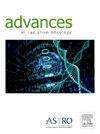Cherenkov Imaged Bio-Morphological Features Verify Patient Positioning With Deformable Tissue Translocation in Breast Radiation Therapy
IF 2.2
Q3 ONCOLOGY
引用次数: 0
Abstract
Purpose
Accurate patient positioning is crucial for precise radiation therapy dose delivery, as errors in positioning can profoundly influence treatment outcomes. This study introduces a novel application for loco-regional tissue deformation tracking via Cherenkov image analysis during fractionated breast cancer radiation therapy. The primary objective of this research was to develop and test an algorithmic method for Cherenkov-based position accuracy quantification, particularly for loco-regional deformations, which do not have an ideal method for quantification during radiation therapy.
Methods and Materials
Bio-morphological features in the Cherenkov images, such as vessels, were segmented. A rigid/nonrigid combined registration technique was employed to pinpoint both inter- and intrafractional positioning variations. The methodology was tested on an anthropomorphic chest phantom experiment via shifting a treatment couch with known distances and inducing respiratory motion to simulate interfraction setup uncertainties and intrafraction motions, respectively. It was then applied to a data set of fractionated whole breast radiation therapy human imaging (n = 10 patients).
Results
The methodology provided quantified positioning variations comprising 2 components: a global shift determined through rigid registration and a 2-dimensional variation map illustrating loco-regional tissue deformation quantified via nonrigid registration. Controlled phantom testing yielded an average accuracy of 0.83 mm for couch translations up to 20 mm in various directions. Analysis of clinical Cherenkov imaging data from 10 breast cancer patients compared with their first imaged fraction revealed an interfraction setup variation of 3.7 ± 2.4 mm in the global shift and loco-regional deformation up to 3.3 ± 1.9 mm (95th percentile of all regional deformation).
Conclusions
This study introduces the use of Cherenkov visualized bio-morphological features to quantify the global and local variations in patient positioning based on rigid and nonrigid registrations. This new approach demonstrates the feasibility of providing quantitative guidance for inter/intrafraction positioning, particularly for the loco-regional deformations that have been unappreciated in current practice with conventional imaging techniques.
切伦科夫成像生物形态学特征验证乳房放射治疗中变形组织移位的患者定位
目的准确的患者体位对于精确的放射治疗剂量递送至关重要,因为体位错误会严重影响治疗结果。本研究介绍了一种基于切伦科夫图像分析的局部区域组织变形跟踪的新应用。本研究的主要目的是开发和测试一种基于cherenkov的位置精度量化算法方法,特别是对于局部区域变形,这在放射治疗期间没有理想的量化方法。方法与材料对Cherenkov图像中的血管等生物形态学特征进行分割。采用刚体/非刚体组合配准技术,精确定位了相互作用和相互作用下的定位变化。该方法在拟人化胸影实验中进行了测试,通过移动已知距离的治疗沙发和诱导呼吸运动来分别模拟干涉设置不确定性和屈光度运动。然后将其应用于分次全乳房放射治疗人类成像数据集(n = 10例)。结果该方法提供了由2个组成部分组成的量化定位变化:通过刚性配准确定的全球位移和通过非刚性配准量化的局部区域组织变形的二维变异图。受控模体测试的平均精度为0.83毫米,沙发在各个方向上的平移高达20毫米。对10例乳腺癌患者的临床Cherenkov成像数据进行分析,发现其整体移位的干涉设置变化为3.7±2.4 mm,局部区域变形高达3.3±1.9 mm(占所有区域变形的第95个百分位数)。本研究引入了Cherenkov可视化生物形态学特征来量化基于刚性和非刚性注册的患者体位的整体和局部变化。这种新方法证明了为射孔间/射孔内定位提供定量指导的可行性,特别是对于目前传统成像技术无法识别的局部区域变形。
本文章由计算机程序翻译,如有差异,请以英文原文为准。
求助全文
约1分钟内获得全文
求助全文
来源期刊

Advances in Radiation Oncology
Medicine-Radiology, Nuclear Medicine and Imaging
CiteScore
4.60
自引率
4.30%
发文量
208
审稿时长
98 days
期刊介绍:
The purpose of Advances is to provide information for clinicians who use radiation therapy by publishing: Clinical trial reports and reanalyses. Basic science original reports. Manuscripts examining health services research, comparative and cost effectiveness research, and systematic reviews. Case reports documenting unusual problems and solutions. High quality multi and single institutional series, as well as other novel retrospective hypothesis generating series. Timely critical reviews on important topics in radiation oncology, such as side effects. Articles reporting the natural history of disease and patterns of failure, particularly as they relate to treatment volume delineation. Articles on safety and quality in radiation therapy. Essays on clinical experience. Articles on practice transformation in radiation oncology, in particular: Aspects of health policy that may impact the future practice of radiation oncology. How information technology, such as data analytics and systems innovations, will change radiation oncology practice. Articles on imaging as they relate to radiation therapy treatment.
 求助内容:
求助内容: 应助结果提醒方式:
应助结果提醒方式:


